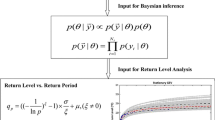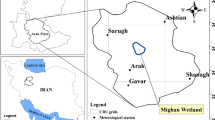Abstract
Designing some long-lasting industrial assets necessitates an estimation of far future extremes. Extreme value estimation is commonly based on an application of the statistical extreme value theory (EVT), which requires that the studied variable is independent and identically distributed, or, at least, stationary. Climate variables exhibit different behaviors which potentially violate this assumption: Seasonality is generally the easiest to handle, and interannual variability is more complicated. Now, as far as temperature is concerned, an additional source of non-stationarity appears: the warming trend, whose interactions with interannual variability add another range of complexity. The approach proposed here is based on the construction of a standardized variable, whose extremes can be considered as stationary. This allows an application of EVT in better accordance with its assumptions. Recent works (Parey et al. in J Geophys Res Atmos 118:8285–8296, 2013. https://doi.org/10.1002/jgrd.50629) have shown that if optimized smooth trends in mean and standard deviation are removed from the temperature time series, then the extremes of the residuals can be considered as stationary. A statistical test has been designed to check this assumption. Here, the inference of high-temperature extremes from the extremes of this standardized variable and future mean and standard deviation projected at the desired time horizon, and given by climate model simulations, is further analyzed and justified.





Similar content being viewed by others
References
Acero FJ, Garcia JA, Cruz Gallego M, Parey S, Dacunha-Castelle D (2014) Trends in summer extreme temperatures over the Iberian Peninsula using nonurban station data. J Geophys Res Atmos 119:39–53. https://doi.org/10.1002/2013JD020590
Acero FJ, Parey S, Hoang TTH, Dacunha-Castelle D, García JA, Cruz Gallego M (2017) Non-stationary future return levels for extreme rainfall over Extremadura (southwestern Iberian Peninsula). Hydrol Sci J. https://doi.org/10.1080/02626667.2017.1328559
Brown SJ, Murphy JM, Sexton DMH, Harris GR (2014) Climate projections of future extreme events accounting for modelling uncertainties and historical simulation biases. Clim Dyn 43:2681–2705. https://doi.org/10.1007/s00382-014-2080-1
Coles S (2001) An introduction to statistical modelling of extreme values, Springer Series in Statistics. Springer, London
Du T, Xiong L, Xu C-Y, Gippel CJ, Guo S, Liu P (2015) Return period and risk analysis of nonstationary low-flow series under climate change. J Hydrol 527:234–250
Hoang TTH (2010) Modélisation de séries chronologiques non stationnaires, non linéaires: application à la définition des tendances sur la moyenne, la variabilité et les extrêmes de la température de l’air en Europe, PhD thesis work (written in English). http://www.tel.archivesouvertes.fr/tel-00531549/fr/
Klein Tank AMG et al (2002) Daily dataset of 20th-century surface air temperature and precipitation series for the European Climate Assessment. Int J Climatol 22:1441–1453. Data and metadata available at http://eca.knmi.nl
Koutsoyiannis D, Montanari A (2015) Negligent killing of scientific concepts: the stationarity case. Hydrol Sci J 60(7–8):1174–1183. https://doi.org/10.1080/02626667.2014.959959
Liang Z, Hu Y, Huang H, Wang J, Li B (2016) Study on the estimation of design value under non-stationary environment. South-to-North Water Transfers. Water Sci Technol 14(1):50–53, 83 (in Chinese)
Mentaschi L, Vousdoukas M, Voukouvalas E, Sartini L, Feyen L, Besio G, Alfieri L (2016) The transformed-stationary approach: a generic and simplified methodology for non-stationary extreme value analysis. Hydrol Earth Syst Sci 20:3527–3547
Montanari A, Koutsoyiannis D (2014) Modeling and mitigating natural hazards: stationarity is immortal! Water Resour Res 50(12):9748–9756
Olsen R, Lambert JH, Haimes YY (1998) Risk of extreme events under nonstationary conditions. Risk Anal 18:497–510
Parey S, Malek F, Laurent C, Dacunha-Castelle D (2007) Trends and climate evolution: statistical approach for very high temperatures in France. Clim Change 81:331–352. https://doi.org/10.1007/s10584-006-9116-4
Parey S, Hoang TTH, Dacunha-Castelle D (2010) Different ways to compute temperature return levels in the climate change context. Environmentrics 21(7–8):698–718. https://doi.org/10.1002/env
Parey S, Hoang TTH, Dacunha-Castelle D (2013) The importance of mean and variance in predicting changes in temperature extremes. J Geophys Res Atmos 118:8285–8296. https://doi.org/10.1002/jgrd.50629
Read LK, Vogel RM (2015) Reliability, return periods, and risk under nonstationarity. Water Resour Res 51(8):6381–6398
Rootzén H, Katz RW (2013) Design life level: quantifying risk in a changing climate. Water Resour Res 49(9):5964–5972
Salas JD, Obeysekera J (2014) Revisiting the concepts of return period and risk for nonstationary hydrologic extreme events. J Hydrol Eng 19(3):554–568
Serinaldi F (2015) Dismissing return periods! Stoch Environ Res Risk Assess 29:1179–1189. https://doi.org/10.1007/s00477-014-0916-1
Serinaldi F, Kilsby CG (2015) Stationarity is undead: uncertainty dominates the distribution of extremes. Adv Water Resour 77:17–36
Yan L, Xiong L, Guo S, Xu CY, Xia J, Duc T (2017) Comparison of four nonstationary hydrologic design methods for changing environment. J Hydrol 551:132–150. https://doi.org/10.1016/j.jhydrol.2017.06.001
Zwiers FW, Zhang XF, Feng Y (2011) Anthropogenic influence on long return period daily temperature extremes at regional scales. J Clim 24(3):881–892. https://doi.org/10.1175/2010JCLI3908.1
Author information
Authors and Affiliations
Corresponding author
Electronic supplementary material
Below is the link to the electronic supplementary material.
Rights and permissions
About this article
Cite this article
Parey, S., Hoang, T.T.H. & Dacunha-Castelle, D. Future high-temperature extremes and stationarity. Nat Hazards 98, 1115–1134 (2019). https://doi.org/10.1007/s11069-018-3499-1
Received:
Accepted:
Published:
Issue Date:
DOI: https://doi.org/10.1007/s11069-018-3499-1




